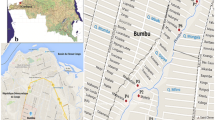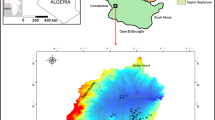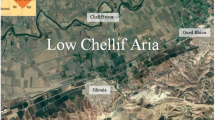Abstract
Located in the southeast of Tunisia, on the Mediterranean Sea, Jerba Island has a semiarid climate condition. The surface water scarcity has made groundwater the main source to supply the domestic, touristic, and agricultural water demand. Unconfined aquifer is a vulnerable costal aquifer system that undergoes several phenomena. This work aims at assessing the geochemical and bacteriological groundwater quality, defining groundwater pollution sources and promoting sustainable development and effective management of groundwater resources in Jerba Island. Data were collected after the wet season in 2014 from 79 wells. Electric conductivity, pH, TDS, and major and fecal tracers (total coliforms, thermotolerant coliforms, Escherichia coli, and Salmonella) were analyzed. Geochemical modeling including the relationships between geochemical tracers Na+ vs. Cl−, Ca2+ vs. Cl−, K+ vs. Cl−, representative ionic ratios (Br−/Cl−, Na+/Cl−, Mg2+/Ca2+), and statistical analysis were used to specify major process contributing to groundwater pollution and main factors controlling groundwater mineralization in the island. Groundwater varieties were hydrochemically classified into three types in terms of salinity values: group 1 (8.86%) to fresh water, group 2 (27.84%) to brackish water, and group 3 (63.29%) belongs to saline water. In addition, groundwater quality revealed high concentrations in chemical pollution tracers (Na+, Cl−, SO4 2−, and NO3 −) and fecal tracers. Besides, most of the sampled wells were contaminated with nitrate (50.63%). Also, thermotolerant coliforms and E. coli were detected in all groundwater samples (96.2% of wells). Results indicated that the Jerba shallow aquifer was under serious threat from both natural and anthropogenic contamination. However, the wild discharge of domestic effluents, septic tanks, and sewage were the main origins of underground water contamination in Jerba Island. The reduction of fecal sources, through constructing normalized latrines is thus recommended.










Similar content being viewed by others
References
Agoubi B (2012) Caractérisation hydrogéologique et géochimique du système aquifère de la Jeffara maritime: Apport des approches géostatistiques. Thèse de doctorat en sciences géologiques, Université de Sfax, 175 p
Agoubi B, Kharroubi A, Abida H (2012) Saltwater intrusion modelling in Jorf coastal aquifer, South-eastern Tunisia: geochemical, geoelectrical and geostatistical application. Hydrol Process journal. doi:10.1002/hyp.9207
Alcala FJ, Custodio F (2008) Using the cl/Br ratio as a tracer to identify the origin of salinity in aquifers in Spain and Portugal. J Hydro 359:189–207
Andreasen DC, Fleck WB (1997) Use of bromide: chloride ratios to differentiate potential sources of chloride in a shallow, unconfined aquifer affected by brackish-water intrusion. Hydrology Journal 5(2):17–26
Aoun Sebaiti B (2010) Gestion optimisée des ressources en eau d’une nappe côtière Application à la plaine d’Annaba (Nord-est Algérien). Thèse de doctorat en Génie Civil. Université Lille 1. 211
Belghiti ML, Chahlaoui A, Bengoumi D, El Moustaine R (2013) Etude de la qualité physico-chimique et bactériologique des eaux souterraines de la nappe Plio-quaternaire dans la région de Meknès (Maroc). Larhyss J ISSN 1112–3680, no. 14, 21–36
Ben Brahim F, Khanfir H, Bouri S (2012) Groundwater vulnerability and risk mapping of the Northern Sfax Aquifer, Tunisia. Arab J Sci Eng 1405–1421
Ben Hamouda MF, Leduc C, Trhouni J, Zouari K (2009) Origine de la minéralisation dans l’aquifère Plio-quaternaire de la côte orientale du cap Bon (Tunisie). Sécheresse 20(1):78–86
Bonton A, Rouleau A, Bouchard C, Rodriguez MJ (2010) Assessment of groundwater quality and its variations in the capture zone of a pumping well in an agricultural area. Agric Water Manag 97:824–834
Bouaziz S, Jedoui Y, Barrier E, Angelier J (2003) Néotectonique affectant les dépôts marins tyrrhéniens du littoral sud-est tunisien: implication pour les variations du niveau marin. Compt Rendus Geosci 335:247–254
Cartwright I, Weaver Tamie R, Fifield Keith L (2006) Cl/Br ratios and environmental isotopes as indicators of recharge variability and groundwater flow: an example from the southeast Murray Basin, Australia. Chem Geol 231:35–56
Chemseddine F, Boudoukha A, Rouabhia A, Salmeh E (2009) Caractérisation hydrochimique des eaux souterraines du complexe aquifère Morsott-Louinet (Région Nord de Tébessa, Sud-Est Algérien). J Afrique Science 14:217–231
Coleman BL, Louie M, Salvadori MI, McEwen SA, Neumann N, Sibley K, Irwin RJ, Jamieson FB, Daignault D, Majury A, Braithwaite S, Crago B, McGeer AJ (2013) Contamination of Canadian private drinking water sources with antimicrobial resistant Escherichia coli. Water Res 47:3026–3063
Degbey C, Makoutode M, Agueh V, Dramaix M, De Brouwer C (2011) Facteurs associés à la qualité de l’eau de puits et prévalence des maladies hydriques dans la commune d’Abomey-Calavi (Bénin). Santé 21. doi:10.1684/san.2011.0238, 47-55
El Moujabber M, BouSamra B, Darwish T, Atallah T (2006) Comparison of different indicators for groundwater contamination by seawater intrusion on the Lebanese coast. Water Resour Manag 20:161–180
Fakir Y, Zerouali A, Aboufirassi M, Bouabdelli M (2001) Potentiel exploitation and salinity of aquifers Chaouia coast. J Afr Earth Sci 32(4):791–801
Fedrigoni L, Krimissa M, Zouari K, Maliki A, Zuppi GM (2001) Origin of the salinisation and hydrogeochemicalbehaviour of a phreatic aquifer suffering severe natural and anthropic constraints: an example from the Djebeniana aquifer (Tunisia). C R Acad Sci Paris, Sciences de la Terre et des planètes/Earth and Planetary Sciences 332:665–671
Howard G, Pedley S, Barrett M, Nalubega M, Johal K (2003) Risk factors contributing to microbiological contamination of shallow groundwater in Kampala, Uganda. Water Res 37(14):3421–3429
Huang G, Sun J, Zhang Y, Chen Z, Liu F (2013) Impact of anthropogenic and natural processes on the evolution of groundwater chemistry in a rapidly urbanized coastal area, South China. Sci Total Environ 463–464:209–221
International Organization for Standardization 9308-1 (2000) Qualité de l’eau-dénombrement des Escherichia coli et des bactéries coliformes-Partie 1: Méthode par filtration sur membrane, Edition 2
Jedoui Y (2000) Sédimentologie et géochimie des Dépôt littoraux quaternaires: reconstitution des variations des climats et du niveau marin dans le sud est tunisien. Thèse de doctorat en sciences géologiques, Université de Tunis II
Khalili B (1986) Hydrogeological study of Jerba unconfined aquifer. Water Resources Direction, Ministry of Agriculture, Tunisia
Kharroubi A, Tlahigue F, Agoubi B, Azri C, Bouri S (2012) Hydrochemical and statistical studies of the groundwater salinization in Mediterranean arid zones: case of the Jerba coastal aquifer in southeast Tunisia. Environ Earth Sci 67:2089–2100
Kim KH, Yun ST, Park SS, Joo Y, Kim TS (2014) Model-based clustering of hydrochemical data to demarcate natural versus human impacts on bedrock groundwater quality in rural areas, South Korea. J Hydrol 519:626–636
Klein B, Roether W, Macana BB, Bregant D, Beitzel V, Kovacevic V, Luchetta A (1999) The large deep water transient in the Eastern Mediterranean. Deep-Sea Res 46:371–414
Kouzana L, Ben Mammou A, Sfar Felfoul M (2009) Seawater intrusion and associated processes: case of the Korba aquifer (Cap-Bon, Tunisia). C R Geoscience 341:21–35
Kumar PJS (2014) Evolution of groundwater chemistry in and around Vaniyambadi industrial area: differentiating the natural and anthropogenic sources of contamination. Chem Erde Geochem 11
Ma J, Ding Z, Wei G, Zhao H, Huang T (2009) Sources of water pollution and evolution of water quality in the Wuwei basin of Shiyang river, Northwest China. J Environ Manag 90(2):1168–1177
Machiwal D, K Jha M (2015) Identifying sources of groundwater contamination in a hard-rock aquifer system using multivariate statistical analyses and GIS-based geostatistical modeling techniques. J Hydrol Reg Stud 31 p
Malana MA, Khosa MA (2011) Groundwater pollution with special focus on arsenic, Dera Ghazi Khan-Pakistan. Journal of Saudi Chemical Society 15:39–47
Marjoua A, Olive PH, Jusserand C (1997) Apport des outils chimiques et isotopiques à l’identification des origines de la salinisation des eaux: cas de la nappe de la Chaouia côtière (Maroc). Revue des sciences de l’eau 4:489–505
McArthur JM, Sikdar PK, Hoque MA, Ghosal U (2012) Waste-water impacts on groundwater: Cl/Br ratios and implications for arsenic pollution of groundwater in the Bengal Basin and Red River Basin, Vietnam. Sci Total Environ 437:390–402
Mondal NC, Singh VP, Singh VS, Saxena VK (2010) Determining the interaction between groundwater and saline water through groundwater major ions chemistry. J Hydrol 388:100–111
Park Y, Lee JY, Kim JH, Song SH (2012) National scale evaluation of groundwater chemistry in Korea coastal aquifers: evidences of seawater intrusion. Environmental Earth Sciences 66(3):707–718
Pulido Leboeuf P, Pulido-Bosch A, Calvache ML, Vallejos A, Andreu JM (2003) Strontium, SO4 2−/cl− and Mg2+/Ca 2+ ratios as tracers for the evolution of sea water into coastal aquifers: the example of castell de Ferro-aquifer. CR Geoscience 335:1039–1048
Sall M, Vanclooster M (2009) Assessing the well water pollution problem by nitrates in the small scale farming systems of the Niayes region, Senegal. Agric Water Manag 96(2009):1360–1368
Schaffter N, Parriaux A (2002) Pathogenic-bacterial water contamination in mountainous catchments. Water Res 36:131–139
Servais P, Passerat J (2009) Antimicrobial resistance of fecal bacteria in waters of the seine river basin (France). Sci Total Environ 408:365–372
Smaoui A, Malha C, Snoussi N, Zamouri M, Yahyaoui H, Chouchane R (1997) Etude agro-économique de l’île de Djerba « situation actuelle », Ministère de l’agriculture. CRDA de Medenine, Tunisie, p 47
Smida H, Abdellaoui C, Zairi M, Ben Dhia H (2010) Cartographie des zones vulnérables à la pollution agricole par la méthode DRASTIC couplé à un Système d’information géographique (SIG): cas de la nappe phréatique de Chaffar (sud de Sfax, Tunisie). Sécheresse 21(2):131–114
Su C, Wang Y, Xie X, Li J (2013) Aqueous geochemistry of high-fluoride groundwater in Datong Basin, Northern China. J Geochem Explor 135:79–92
Taiwo AM (2012) Source identification and apportionmentof pollution sources to groundwater qualityin major cities in Southwest, Nigeria. Geofizika 29:158–174
Tandia A, Diop ES, Gaye CB (1999) Nitrate groundwater pollution in sub-urban areas: example of groundwater from Yeumbeul, Senegal. J Afr Earth Sci 29(4):809–822
Trabelsi R, Zairi M, Smida H, Ben Dhia H (2005) Salinisation des nappes côtières: cas de la nappe nord du Sahel de Sfax, Tunisie. CR Géoscience 377:315–325
Tunisian Standard 09.14 (2013) Eaux destinées à la consommation humaine à l’exclusion des eaux conditionnées
Villanueva CM, Kogevinas M, Cordier S, Templeton MR, Vermeulen R, Nuckols JR, Nieuwenhuijsen MJ, Levallois P (2014) Assessing exposure and health consequences of chemicals in drinking water: current state of knowledge and research needs. Environ Health Perspect 122(3):213–221
World Health Organization (2007) Nitrate and nitrite in drinking water background document for development of WHO guidelines for drinking-water quality. WHO Press, Geneva, p 29
World Health Organization (2008) Guidelines for drinking-water quality, volume 1 recommendations, third edition, 515
Yahyaoui H (2012) Nappe phréatique de l’île de Jerba: Aspects hydrogéologiques et mobilisation des ressources, Ministère de l’agriculture. Comissariat Régionale De l’Agriculture de Medenine, Tunisie, p 7
Yao TK, Oga MS, Fouché O, Baka D, Pernelle C, Biemi J (2012) Évaluation de la potabilité chimique des eaux souterraines dans un bassin versant tropical: cas du Sud-Ouest de la Côte d’Ivoire. Int J Biol Chem Sci (6)6:7069–7086 ISSN 1991–8631
Youmbi JGT, Feumba R, Njitat VT, De Marsily G, Ekodeck GE (2013) Water pollution and health risks at Yaoundé, Cameroon. Comptesrendus Biologies 336:310–316
Yu Y, Song X, Zhang Y, Zheng F, Liang J, Han D, Ma Y, Bu H (2013) Identification of key factors governing chemistry in groundwater near the water course recharged by reclaimed water at Miyun County, Northern China. Journal of of Environmental Sciences 25(9):1754–1763
Zammouri M, Siegfried T, El-Fahem T, Kriâa S, Kinzelbach W (2007) Salinization of groundwater in the Nefzawa oases region, Tunisia: results of a regional-scale hydrogeologic approach. Hydrogeol J 15:1357–1375
Acknowledgements
The authors are grateful to Kamel Maaloul, interpreter and English professor for having proofread the manuscript.
Author information
Authors and Affiliations
Corresponding author
Rights and permissions
About this article
Cite this article
Souid, F., Agoubi, B., Hamdi, M. et al. Groundwater chemical and fecal contamination assessment of the Jerba unconfined aquifer, southeast of Tunisia. Arab J Geosci 10, 231 (2017). https://doi.org/10.1007/s12517-017-2981-5
Received:
Accepted:
Published:
DOI: https://doi.org/10.1007/s12517-017-2981-5




